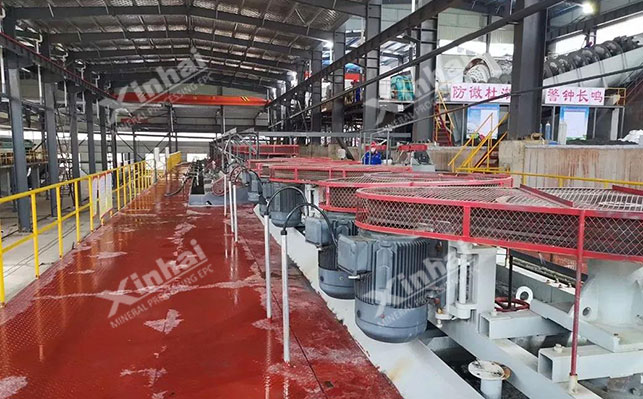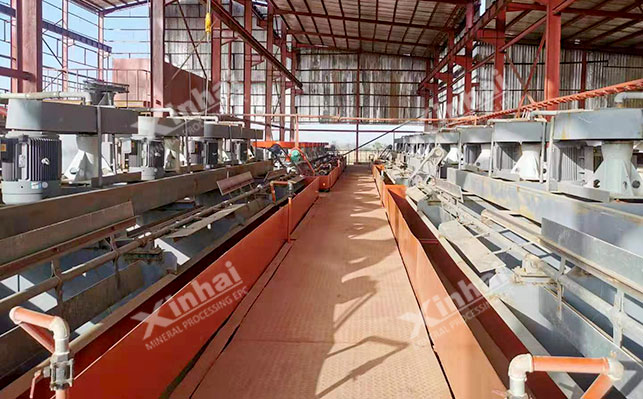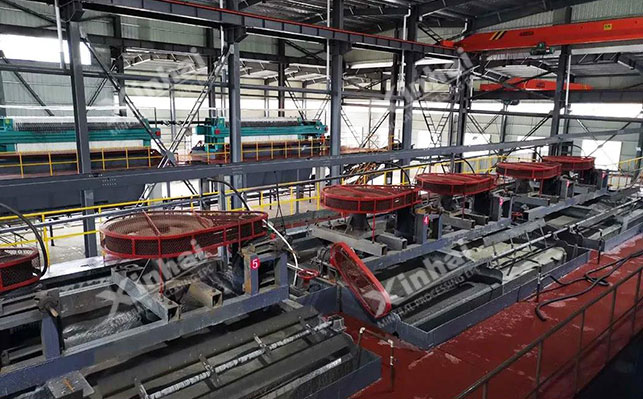
15311826613
Click to add WeChatMolybdenum is a rare metal mineral and an important strategic material. It has high melting point, thermal and electrical conductivity, high temperature resistance, wear resistance, corrosion resistance and other properties. In nature, molybdenum ore often exists in the form of single molybdenum ore, copper-molybdenum ore or other polymetallic molybdenum ores. In terms of mineral processing methods, because molybdenum has good floatability, flotation is often used as the main method. The following article will start with these three types of molybdenum ores and take you to understand the molybdenum ore beneficiation process.
Single molybdenum ore mainly exists in the form of molybdenite, which has good hydrophobicity and is a non-polar mineral with good floatability. . Flotation is often used as a method to separate molybdenite, and sometimes molybdenite only needs to be added with a frother to float. Non-polar hydrocarbon (ting, one sound) oil can be used as a collector of molybdenite, including kerosene, diesel, etc. The inhibitor is generally dextrin, and water glass is used as a medium regulator for molybdenite flotation. Molybdenite can float when the exposed surface area of molybdenite is small, so coarse grinding-rough separation can be used in the rough selection stage, and then regrind the rough selection product, >Selection after full dissociation.

There are two issues that need to be paid attention to during the flotation of molybdenite. The first is the enrichment of molybdenite. Although molybdenite is a metal mineral that floats easily, the molybdenum content in the ore is relatively low, generally between 0.01% and 0.4%, while the required molybdenum content for molybdenum concentrate is 45%. %~47% or more, the concentration ratio of molybdenite is relatively high, so molybdenite flotation generally requires 4 to 10 times of beneficiation. The other is that the hardness of molybdenite is relatively soft, and it is easy to produce slime during the fine grinding process, which has a great impact on the quality of the concentrate. Therefore, water glass is used as a dispersant in the chemical system of molybdenite flotation to inhibit Effect of slime on concentrate quality.
Copper-molybdenum ore is also one of the main mineral resources for obtaining molybdenum. Copper is a copper ore with associated molybdenum minerals, generally phyllite. Copper ore, while molybdenum exists in the form of molybdenite, often closely symbiotic with chalcopyrite and pyrite, and it is difficult to recover molybdenum minerals. The focus of the copper-molybdenum ore beneficiation process is the separation of copper and molybdenum.

According to differences in floatability, copper-molybdenum ores can be divided into two categories: easy-to-float and difficult-to-float< /strong>, there is a clear gap in the beneficiation indicators of these two types of copper-molybdenum ores. The molybdenum recovery rate of the easily floatable copper-molybdenum ore is 85%~90%, but the molybdenum content of the raw ore is only It is 0.08%~0.2%, while the molybdenum recovery rate of difficult-to-float copper-molybdenum ore is about 50%. The easily floating copper-molybdenum ore contains copper sulfide and molybdenite. Both minerals are easy to float and have similar floatability. They are closely connected and difficult to separate. In copper-molybdenum separation, two methods, priority flotation and mixed flotation, are generally used.
Preferential flotation of copper-molybdenum ores: Generally molybdenum is flotated first and then copper is flotated, but the disadvantage is that it is difficult to flotate copper minerals after being suppressed. Resurrected, difficult to recycle and therefore rarely used.
Mixed flotation of copper-molybdenum ore: It first uses black powder, xanthate, kerosene and other collectors to flotate the copper-molybdenum rough concentrate, and then from the copper-molybdenum rough concentrate Separation of molybdenum minerals from mines. Before the mixed concentrate is separated, it will be concentrated and decontaminated to reach a solid concentration of 45% to 60%. After concentration, dosing treatment is carried out, and hydrocarbon oil collectors are used to flotate molybdenum minerals, but their dosage needs to be controlled to prevent copper minerals from being mixed into the molybdenum concentrate.
Molybdenum ore is often accompanied by other valuable elements such as copper, tungsten, gold, silver, rhenium, sulfur, iron, etc., although its grade It is not high, but it also has recycling value when molybdenum reserves are relatively large. Therefore, polymetallic molybdenum mines attach great importance to its comprehensive recycling.
For example, quartz vein gold, molybdenum, lead, sulfur, polymetallic molybdenum ore can be recovered by flotation, and the mixed coarse concentrate can be cyanide leached to recover the gold, and then the tailings can be leached to recover the molybdenum concentrate. The ore can be separated by flotation, and then the tailings of the flotation molybdenum concentrate can be separated from lead and sulfur to recover the lead concentrate and sulfur concentrate.

As another example, low-grade tungsten, molybdenum and bismuth ores can be processed by the molybdenum and bismuth mixing and separation process. The total flotation process can be used as a recovery method for molybdenum and bismuth. After the mixed coarse concentrate of molybdenum and bismuth is obtained, molybdenum-bismuth-sulfur separation and molybdenum-bismuth separation are performed. The combined beneficiation process of flotation and gravity separation recovers tungsten minerals, and cooperates with highly efficient and selective gangue inhibitors to obtain tungsten coarse concentrate. It then uses high-concentration heating and stirring to remove the drug and conduct flotation and concentration to obtain tungsten concentrate. .
The above are three common molybdenum ore beneficiation process methods. In actual production, the above processes can only be used as a reference and cannot be applied randomly. Even if they are the same type of molybdenum ore, the ore properties, ore The processing capacity, etc. are also different, so it is necessary to conduct mineral processing experiments and design a suitable molybdenum ore mineral processing process through experimental analysis. Xinhai Mining can provide services throughout the mining industry chain. It can not only provide molybdenum ore beneficiation tests, but also customize molybdenum ore beneficiation process flow, molybdenum ore beneficiation plant construction plans and supporting molybdenum ore beneficiation equipment. In addition, it can also It can carry out installation, commissioning and later operation and maintenance work for its mineral processing plant.